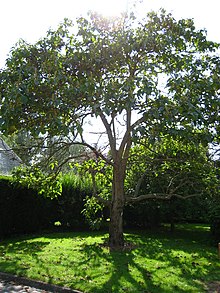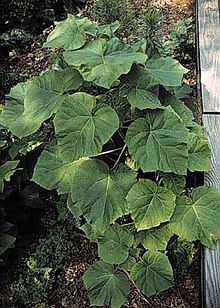Paulownia
| Paulownia | |
|---|---|

| |
| Scientific classification | |
| Kingdom: | Plantae |
| Clade: | Tracheophytes |
| Clade: | Angiosperms |
| Clade: | Eudicots |
| Clade: | Asterids |
| Order: | Lamiales |
| Family: | Paulowniaceae |
| Genus: | Paulownia Siebold & Zucc. |
| Species | |
|
Six to 17 species, including: | |
Paulownia (
It was originally sought after as an exotic ornamental tree in Europe and Asia, and later introduced to North America in 1844. Its fruits (botanically
Paulownia trees produce as many as 20 million tiny seeds per year. However, the seeds are very susceptible to
Dimensionally stable and given its straight grain and light weight, Paulownia timber is extremely easy to work with and is reported to be resistant to decay, with decent weathering.[6]
Trees can grow to maturity in under 10 years and produce strong, lightweight timber, good as firewood, with an even higher strength to weight ratio than balsa wood.[7] Its density is low at around 0.28 kilograms per liter (2.8 lb/imp gal),[8][7][9] although significantly higher than balsa's very low 0.16 kilograms per liter (1.6 lb/imp gal).[10][11]
Morphology

Paulownia is a genus of
trilobed lower lip. The lips of all the petals are curled and their surface tomentose.
On the inner side of the lower trilobed corolla tube run two light yellow folded ridges from the calyx to the lip. These are interpreted as
Fossil record
Paulownia once occurred in
Paulownia macrofossils have been recovered from the late Zanclean stage of the Pliocene sites in Pocapaglia, Italy[16] and Paulownia caucasica macrofossils have been recovered from strata of the Serravallian stage of the Miocene in Georgia in the Caucasus region.[17] It is believed that the climate then would have been suitable for the genus across the whole northern hemisphere.[18]
Uses
This section needs additional citations for verification. (July 2017) |
In China, it is popular for roadside planting and as an ornamental tree. Paulownia needs much light and does not like high water tables.
As a forestry crop Paulownia are exacting in their requirements, performing well only in very well draining soil, with summer rainfall or availability of irrigation water.[citation needed] Paulownia is extremely fast growing; up to 20 feet in one year when young. Some species of plantation Paulownia can be harvested for saw timber in as little as five years. Once the trees are harvested, they regenerate from their existing root systems, earning them the name of the "Phoenix tree".[citation needed]
Paulownia is also used in Chinese agroforestry systems because it grows fast, its wood is light but strong, its flowers are rich in nectar, its leaves make good fodder for farm animals, it is deep-rooting, and it is late-leafing and its canopy is quite sparse so that crops below it get both light enough to grow and shelter.[19]

Paulownia is known in Japanese as kiri (桐), specifically referring to P. tomentosa; it is also known as the "princess tree". Paulownia is the mon of the office of prime minister, and also serves as the Government Seal of Japan used by the Cabinet and the Government of Japan (whereas the chrysanthemum is the Imperial Seal of Japan).[citation needed] It is one of the suits in the card game hanafuda, associated with the month of November or December (some regions reverse the order of these two months).[20]
Japan: An Illustrated Encyclopedia states:
Paulownia wood is very light, fine-grained, and warp-resistant. It is the fastest-growing hardwood. It is used for chests, boxes, and clogs (geta). The wood is burned to make charcoal for sketching and powder for fireworks, the bark is made into a dye. The silvery-grey wood is sliced into veneers for special visiting cards.[21][22]

It is important in China, Korea, and Japan for making the soundboards of stringed musical instruments such as the
Species

Tested and confirmed species:[15]
Potential variety, hybrid, and synonym species:
- Paulownia coreana
- Paulownia glabrata
- Paulownia grandifolia
- Paulownia imperialis
- Paulownia australis
- Paulownia lilacina
- Paulownia longifolia
- Paulownia meridionalis
- Paulownia mikado
- Paulownia recurva
- Paulownia rehderiana
- Paulownia shensiensis
- Paulownia silvestrii
- Paulownia thyrsoidea
- Paulownia duclouxii
- Paulownia viscosa
References
- ^ Barton, I.L.; Nicholas, I.D.; Ecroyd, C.E. (2007). "Pawlonia" (PDF). Forest Research Bulletin. 231.
- ^ Rush Industries, 2000.
- S2CID 40567325.
- ^ "Paulownia tomentosa". www.tsusinvasives.org. Retrieved 2019-12-20.
- ^ Cultivation of Paulownia - 3. Sexual & Asexual Propagation Archived 2021-10-27 at the Wayback Machine www.kalliergeia.com, accessed 20 May 2020
- ^ characteristics
- ^ a b c "Paulownia | The Wood Database - Lumber Identification (Hardwood) Common Name(s): Paulownia, Royal Paulownia, Princess Tree, Kiri". Retrieved 2019-12-20.
- S2CID 211028012.
- ^ "Physical and mechanical properties of paulownia tomentosa wood planted in hungaria". ResearchGate.
- ^ "Balsa | WoodSolutions". www.woodsolutions.com.au.
- S2CID 6546811.
- S2CID 103106687.
- ^ ISSN 0367-2530.
- ^ JSTOR 2439100.
- ^ PMID 31114599.
- ^ Messian to Zanclean vegetation and climate of Northern and Central Italy by Adele Bertini & Edoardo Martinetto, Bollettino della Societa Paleontologica Italiana, 47 (2), 2008, 105-121. Modena, 11 lugio 2008.
- ISBN 978-9941-9105-3-1
- ISSN 0002-9122.
- ISBN 9780851991474.
- ^ Go-Stop: THE CARDS "...called hwa-tu in Korea, and hanafuda in Japan... NOVEMBER - PAULOWNIA (Korean: odong. Note: in Japanese hanafuda, Paulownia represents December.)" www.sloperama.com, accessed 21 May 2020
- ISBN 4-06-931098-3. page 1189.
- ^ Lincoln, William L. (1986). World Woods in Color. Fresno: Linden Publishing. p. 143.
- ^ "Understanding the Wood Core in Your Skis". POWDER Magazine. 2016-08-31. Retrieved 2020-01-26.
- ^ "The 13 best backcountry skis of 2020". FREESKIER. 2019-09-17. Retrieved 2020-01-26.
- ^ Paulownia Lumber For Sale 21 January 2019 www.commercialforestproducts.com, accessed 20 May 2020
- ^ "Paulownia fortunei Fact Sheet". Archived from the original on 2013-10-25. Retrieved 2012-06-25.
{{cite web}}: CS1 maint: bot: original URL status unknown (link)
